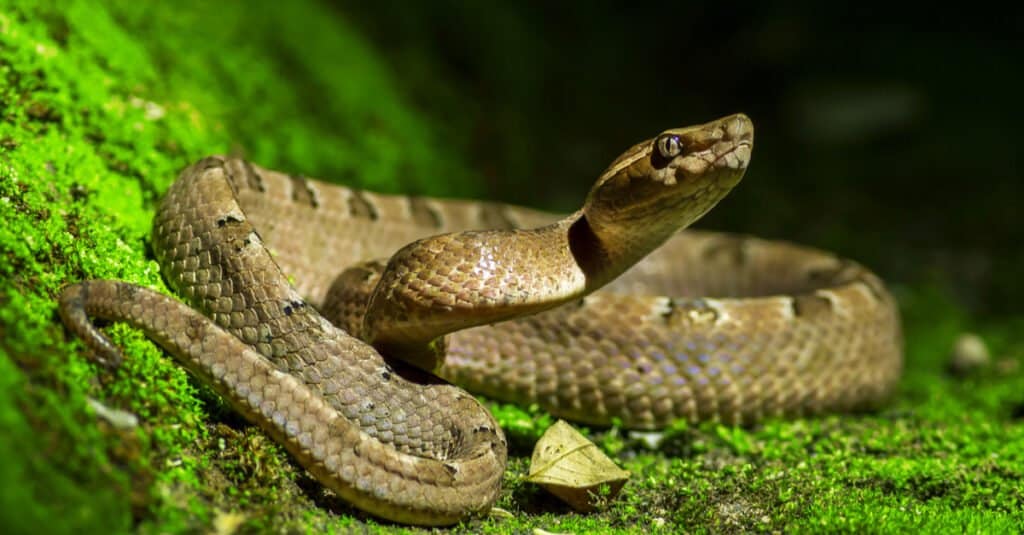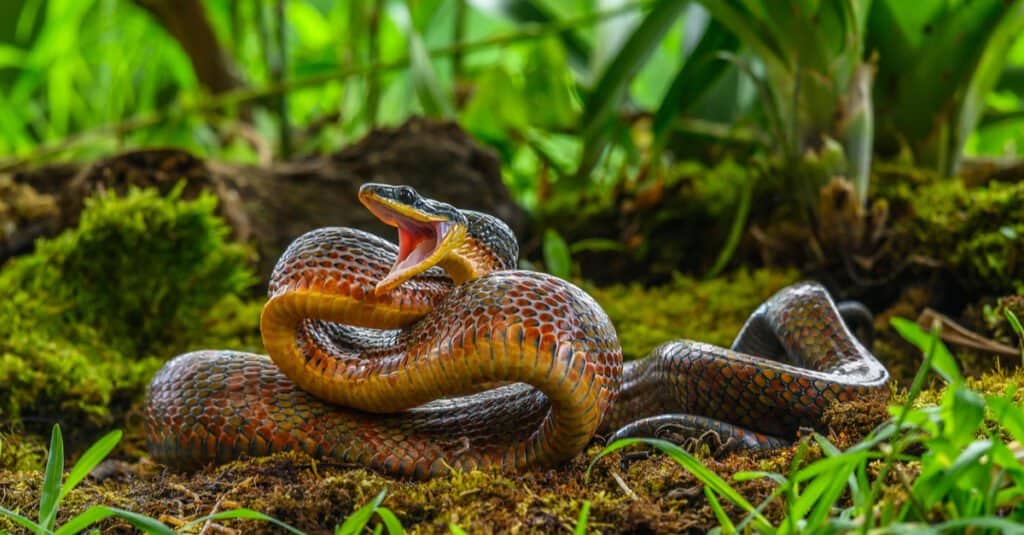Pooping may come naturally to snakes, as it does to all animals, but it’s far from a simple process. The ability to pass waste is inevitably linked to the consumption of biological resources, which typically take the form of prey animals.
Poop is essentially comprised of all the components of the snake’s food that are not used by the body. Anything that is not absorbed into the body during digestion is passed as waste through the cloaca at the termination of the intestinal tract.
Understanding how snakes poop also means understanding how they consume and digest their food. There are a lot of different factors that depend on the type of snake. Among the hundreds of snake species are many different variations of internal anatomy, prey selection, and rate of consumption.
Additionally, snakes get rid of waste in the same way other animals do. Once everything has been completely digested, the waste goes through an opening near the end of the tail. However, snakes don’t really pee in the same way one might expect. The same hole that snakes defecate, mate, and lay eggs is the same opening used for urination.
Individual health and environmental factors can also impact the digestive process.
Four Quadrants of the Snake

©Worraket/Shutterstock.com
Before delving into the specifics of snake digestion, it helps to understand some of the basics of snake anatomy. Biologists typically divide the snake body into four parts, called quadrants, that coincide with the placement of their internal organs.
Since food passes straight from the head to the tail, it’s relatively easy to trace the digestive process from start to finish through each progressive quadrant.
The first quadrant contains the mouth, trachea, and esophagus of the snake, along with the heart and several glands that aren’t directly related to digestion. The esophagus continues through the second quadrant, which also contains the lung and liver.
It terminates directly into the stomach in the third quadrant where the snake’s body starts to break down the ingested material. As the food breaks down it passes into the small intestine then the large intestine, located in the fourth quadrant, before being eliminated through the cloaca.
Food Consumption
A snake’s eating habits are directly related to how they poop. Some species consume large meals at infrequent intervals, particularly in the wild. A snake may consume an entire rabbit or large rodent for example, but not eat again for weeks or months.
This means that they digest and eliminate a large amount of waste all at once but then won’t defecate again until after their next meal.
Snakes can see up to a two-fold increase in body mass following a meal and up to 20 percent of their body weight can be composed of feces. On the other hand, domesticated snakes that eat many smaller meals will pass smaller amounts of poop far more frequently than their wild counterparts.
Owners of pet snakes are advised to research ideal meal frequency and size according to the species, age, and weight of their pet.
Initial Digestion
Humans and many other mammals do a lot of their digestion in their mouths, but this is not the case for snakes. Snakes don’t chew their food, so their teeth are primarily for dispensing venom or latching on to their target. Their saliva also doesn’t have the same properties as it does in mammals, so it mostly serves to preserve interior tissue and lubricate the esophagus.
While food passes through the esophagus in much the same state that it entered the snake’s mouth, the stomach is a different matter. This tube-like organ secretes various enzymes and acidic chemicals that break down solid matter into smaller bits.
The snake’s stomach also creates internal motion that moves food around, which further aids the digestive process. Food can remain in a snake’s stomach much longer than that of a mammal, with some meals lingering for days or weeks before passing to the intestines.
Nutrient Extraction

©Vaclav Sebek/Shutterstock.com
Once it’s been thoroughly broken down by the stomach, food material passes through a valve called a pylorus into the small intestine. The first section of the small intestine is called the duodenum and is built with a thicker wall than the rest of the organ. Some several organs and glands secrete various chemicals into the intestines to facilitate digestion, including the pancreas and gall bladder.
The length and shape of the small intestine vary among snake species. Some are essentially straight from the stomach to the colon, while others have loops that extend their effective length to ensure more efficient absorption of nutrients.
In either case, the small intestine eventually empties into the large intestine, which finishes the nutrient extraction process and prepares waste for elimination.
Final Waste Disposal
Snakes typically deposit the waste from a meal all at once, so feces are stored up near the end of the large intestine until all of the food has been fully digested. The large intestine terminates into a chambered structure called the cloaca, which also functions as the point of elimination for urine. The cloaca also serves in the animal’s reproductive processes as a passageway for sperm in males and egg-laying in females.
Feces and urine are eliminated simultaneously after being passed into the rear-most chamber of the cloaca, which is known as the proctodeum. This chamber collects and mixes all of the animals’ waste matter before passing it out of the body. Depending on the species, snakes may have bone spurs and scent glands around this opening.
Potential Complications
The extreme nature of snake eating and pooping habits can be the source of serious health risks. Impaction is a particularly dangerous complication of the digestive process. This happens when food or waste matter becomes lodged in the digestive tract, typically the intestines, and won’t move for prolonged periods.
This can prevent nutrients from entering the animal’s bloodstream and ultimately rupture the organ, leading to death.
Vent prolapse is another serious complication that can arise spontaneously but is often associated with extreme constipation or impaction. Strain when passing excrement can push part of the intestine outwards and typically requires immediate medical intervention.
There are also several types of bacterial and protozoan infections that can disrupt a snake’s digestive system and ability to pass feces safely.
Next Up…
- How To Catch A Snake – Need to catch a snake the correct way without you or the snake getting harmed? Keep reading!
- How Do Snakes Move? – Snakes are known for their S-like movement, however, snakes can also move in a straight line. Find out how right now!
- Snake Lifespan: How Long Do Snakes Live? – How long can snakes live? Many live long, fulfilling lives in captivity, but how long exactly? Click to learn more!
The photo featured at the top of this post is © Subodh Mahobe/Shutterstock.com
Discover the "Monster" Snake 5X Bigger than an Anaconda
Every day A-Z Animals sends out some of the most incredible facts in the world from our free newsletter. Want to discover the 10 most beautiful snakes in the world, a "snake island" where you're never more than 3 feet from danger, or a "monster" snake 5X larger than an anaconda? Then sign up right now and you'll start receiving our daily newsletter absolutely free.
Thank you for reading! Have some feedback for us? Contact the AZ Animals editorial team.






